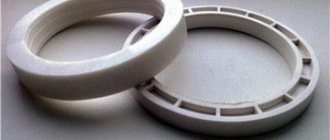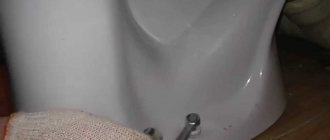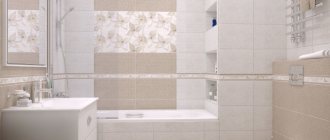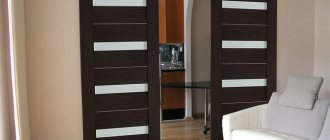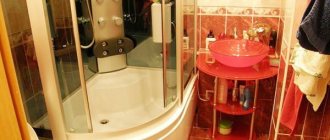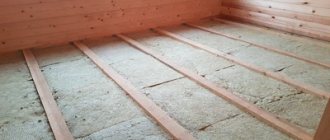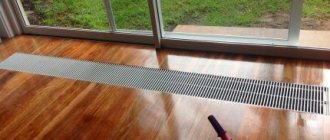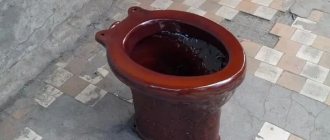The parameters of bathrooms in apartments do not always have sufficient area for the standard placement of all key plumbing fixtures. The solution to this problem lies in clearly thinking through the location and choosing compact models of functional key items. One of which is a corner toilet with a cistern - an advantageous design for the original design of an adjacent bathroom.
In this article we will analyze in detail the advantages and disadvantages of such toilet models, possible installation schemes and focus on the features of their connection to communication networks. We will supplement the presented material with visual photos and useful tips on choosing a suitable toilet for installation in the corner of the bathroom.
Pros and cons of corner plumbing fixtures
The design of corner toilets is practically no different from the standard version. The difference lies in the shape of the tank; it is made in the form of a triangle, although this design does not have any effect on the volume of the container.
A toilet in the corner of a bathroom or toilet allows you to increase the free space in the room and makes its interior extraordinary. By filling the corners with plumbing fixtures, you can visually increase the internal space by acquiring rounded shapes.
Corner toilets are available in two versions:
- Monoblock
. The model is a structure of two connected parts, a floor-standing toilet and a flush cistern. - Compact
. This model uses a wall-hung toilet, and the tank is installed in a corner niche. In some cases, the water supply and drainage system is disguised behind a false wall. When purchasing such structures, you must remember that their weight can be up to 500 kg.
If the bathroom in the apartment is separate, then additional devices can be placed in the toilet room, for example, a bidet and a corner wall-hung toilet. Suspended structure
The main advantage of corner toilets is the strength and reliability of the cistern. In such cases, it is made of solid material, which completely eliminates the formation of leaks.
Most of the corner-type models are equipped with an emergency system, thanks to which, in the event of a breakdown, excess network water is directed into a special overflow channel. Installing such plumbing equipment allows the owner not to think about the problem of flooding of neighbors below.
Among the disadvantages of such models is the rather large weight, which should be taken into account when installing a corner toilet. To install wall-hung toilets, you must choose a solid wall. In the case of plasterboard wall structures, it is necessary to place a strong embedded material under the sheathing. The toilet is attached to it with bolts, the length of which should be sufficient to pass through the wooden elements and grip the main wall.
How to save money?
Owners of tiny bathrooms can also save on purchasing a toilet. Since not everyone is willing to pay a lot of money for corner models, there is an option to simply purchase a compact toilet that will fit successfully into the corner of the room.
Compact designs have a smaller tank width so it can easily fit into any corner. Plumbing of this type looks harmonious. And the cost of such products can be an order of magnitude lower than corner models. For example, a budget option will cost from 3,000 rubles.
Modern plumbing is represented by a variety of models; manufacturers have long moved away from classical standards. The main task of the equipment is to solve the problems of interior design in the bathroom. And corner toilets do an excellent job of organizing limited space.
0 0 votes
Article rating
Types of corner toilets with a cistern
Recently, more and more often, consumers are choosing non-standard plumbing fixtures, which are characterized by original appearance, comfort and functionality. This category of products includes corner toilets, which not only have a different cistern shape from standard models, but also some features of the installation process.
When choosing a corner toilet, you need to consider various factors. In particular, we are talking about the material of manufacture, the shape of the bowl, the type of sewer outlet and the method of fastening the plumbing. It is worth noting that such products are presented in a less wide range compared to the classic version.
Rating of the best models
Floor-standing corner toilets
VitrA Arkitekt 9754B003-7201
A fairly compact model from a Turkish manufacturer, combining both elegant design and high-quality quality. Made from glazed porcelain, the non-porous surface of which does not absorb moisture or unpleasant odors. The funnel shape ensures minimal splashing. Equipped with a horizontal outlet (into the wall) and a mechanism for smoothly lowering the lid. The cascade type flow helps to effectively clean the bowl. The product is easy to clean and with regular care does not lose its original appearance even after long-term use.
VitrA Arkitekt 9754B003-7201
Advantages:
- high level of strength;
- load degree up to 0.6 tons;
- economical;
- ease of installation;
- comfortable use;
- easy care and hygiene;
- aesthetic design;
- acceptable price.
Flaws:
- difficulties arise when cleaning the container in the wall area;
- In some cases, defective elements are found.
Ideal STANDART Connect Space E119501
The model perfectly combines constructive solutions and modern design.
A bowl made of faience is in no way inferior to porcelain models, fully corresponding to them both in terms of strength and durability, and in terms of aesthetics. The oval shape of the toilet offers the owner all the advantages of a traditional configuration, while combining style and elegance. Fits perfectly into the interior of any bathroom. Thanks to the more universal horizontal exhaust system, the toilet can be installed either close to or at some distance from the wall. The bowl of the product has a special shape that prevents excessive splashes, splashes and unpleasant odors. The mechanism of the drainage tank provides 2 drainage modes - full and half, contributing to the economical consumption of water.
Ideal STANDART Connect Space E119501
Advantages:
- compactness;
- practicality;
- economy mode;
- high quality materials;
- easy to care for;
- Ease of use;
- long service life.
Flaws:
- not suitable for tall and obese people;
- high price.
Jacob Delafon Odeon Up 18557K
A compact toilet from a French company, equipped with a funnel-shaped porcelain sink, a thermoduric seat - a lid with a micro-lift function and a pentagonal-shaped tank with a double button.
The presence of corrugation allows installation both “to the wall” and to the “floor”. In addition, the model has a silent bottom supply, all-round flushing and an anti-splash function.
Jacob Delafon Odeon Up 18557K
Advantages:
- optimizes room space;
- efficiency;
- quick installation;
- Ease of use;
- easy care;
- elegant appearance.
Flaws:
- sometimes there may be a lot of splashing;
- Over time, the button sinks in an empty tank.
Hatria You&Me YXZ601
The model is made of sanitary faience in high-tech style. Equipped with a horizontal type of outlet (into the wall), a “microlift” function, as well as a comfortable plastic seat.
The oval-shaped bowl is washed by a funnel-shaped stream of water. The glazed surface prevents the growth of bacteria, the formation of lime deposits and the accumulation of various types of contaminants. The anti-splash system prevents large amounts of splashing when flushing.
Hatria You&Me YXZ601
Advantages:
- high quality;
- reliability and versatility;
- you can select the drain mode (depending on the installation);
- easy to care for;
- convenient use;
- unique design.
Flaws:
- short warranty period;
- high price;
- difficult installation (due to the heavy weight and bulkiness of the structure).
SEREL Friendly 6706
The peculiarity of this model is the special shape of the drain. It is offset relative to the center of the toilet with a lower water level in the hole. The manufacturing material is porcelain. The tank fittings and fasteners are of fairly high quality and are resistant to corrosion. The water supply is carried out from the bottom of the tank. There are also 2 drain modes - full and economical.
The glazed surface is quite dense and smooth, has low water absorption, which does not allow dirt and numerous bacteria to settle on it. The set also includes a comfortable seat made of Duroplast.
SEREL Friendly 6706
Advantages:
- complete set that greatly simplifies the purchasing and installation process;
- economical water consumption;
- simple installation;
- high level of comfort during use;
- hygiene;
- ergonomic design;
- affordable price.
Flaws:
- accumulation of dirt behind the tank in the corner area.
Creavit Corner SD310
A bidet toilet consisting of a faience bowl made in the shape of an oval, a triangular tank and a seat cover made of duroplast. The model is equipped with a special coating that prevents the growth of microbes and greatly simplifies the care of the product.
There is also a “microlift” function, a double flush button for complete and economical water consumption, a bidet for taking a hygienic shower, as well as a bottom liner.
Creavit Corner SD310
Advantages:
- complete hygiene of use;
- practicality;
- economical use of water;
- no significant splashes;
- smooth lowering of the lid;
- easy to care for;
- long service life.
Flaws:
- made of sanitary ware, which is inferior in strength and moisture resistance to sanitary porcelain.
The best hanging corner models
Roca Mateo 346200000 + Geberit Sigma 111.300.00.5
Plumbing kit consisting of a wall-hung toilet and a corner installation.
The design of the toilet is an oval bowl, made of sanitary porcelain and equipped with a comfortable seat-lid. The outlet type is horizontal, it has a microlift function and an anti-splash system.
The corner installation consists of a steel frame, a plastic tank and a panel with two buttons. The kit also includes a water pipe and a sewer elbow.
Roca Mateo 346200000 + Geberit Sigma 111.300.00.5
Advantages:
- full set;
- high degree of strength;
- economical water consumption;
- Ease of use;
- easy to care for;
- long service life.
Flaws:
- not the easiest installation;
- in case of serious damage, the partition must be dismantled.
Ifo Special RP731300200 + Geberit Sigma 111.300.00.5
Plumbing kit for concealed installation, consisting of a corner installation and a wall-hung toilet.
The installation consists of a steel frame with a plastic tank, a drain pipe, an outlet sewer elbow and a two-button panel.
The toilet itself is a rimless bowl made of porcelain, equipped with a comfortable lid-seat. The outlet type is horizontal, with an anti-splash function.
Ifo Special RP731300200 + Geberit Sigma 111.300.00.5
Advantages:
- ready-to-install kit that does not require the purchase of additional parts;
- double drain mode;
- the ability to regulate the volume of drainage;
- reliability, strength and safety;
- withstands weight up to 400 kg;
- Ease of use;
- easy to care for;
- acceptable price.
Flaws:
- complex installation;
- inaccessibility of some areas for repair work (sometimes it is necessary to resort to dismantling the partition).
Cersanit City Clean On MZ-CITY_Con-S-DL + Geberit Sigma 111.300.00.5
A complete sanitary kit, including a wall-hung toilet and a corner installation.
The material used to make the toilet bowl is earthenware. Due to the anti-splash function, excessive splashing during flushing is eliminated. The seat-lid is made of duroplast and has a smooth lowering mechanism (without clapping).
The installation includes a rectangular steel frame, a plastic tank, a two-button panel, and piping. The kit contains all the necessary fasteners.
Cersanit City Clean On MZ-CITY_Con-S-DL + Geberit Sigma 111.300.00.5
Advantages:
- full set;
- high level of strength;
- the ability to regulate the volume of drainage;
- aesthetic appearance;
- practicality;
- ease of use and care.
Flaws:
- difficult installation;
- during operation, cracks may appear on the seat;
- The bowl shape is not entirely convenient for men.
Material of manufacture
In the production of corner toilets, standard materials are used, such as plastic, porcelain, earthenware.
The material for the manufacture of most plastic toilets is acrylic, reinforced with fiberglass and special resin. The products are lightweight and simple, have a high degree of strength and a non-porous structure. This is the main advantage of plastic toilets. However, such plumbing does not tolerate temperature changes and strong mechanical stress.
Porcelain toilets are characterized by higher strength, which significantly increases the service life of such products. Corner toilets with a complete cistern are made from white clay with the addition of quartz and feldspar, which makes the structure of the material less porous. The final coating – a special glaze – ensures the surface of the toilet is perfectly smooth, making maintenance of the equipment quick and easy. The disadvantages include a higher price level.
Earthenware toilets are among the plumbing fixtures with an affordable price. Thanks to additional firing of earthenware products and glazing at the final stage of production, the porosity of the material is reduced, the service life of finished products is increased, and maintenance of plumbing fixtures becomes more convenient and faster. The average service life of earthenware toilets is about 15 years.
Bronze and steel toilets, as well as plumbing fixtures made from natural materials, are much less common, since the cost of such products is very high. This is the main reason for low consumer demand, so the model range is very rarely replenished with new products.
In public places you can often find corner toilets made of galvanized steel. They are a structure in which the toilet is combined with a sink. Therefore, such equipment can be classified as anti-vandal goods.
Most standard models are made of porcelain. In their production, high-quality materials are used, which are characterized by a low degree of moisture absorption. Such models retain their functional and visual qualities throughout their entire service life.
What should you consider when making your choice?
To choose a reliable and not too expensive corner toilet with a cistern, you need to know which parameters you should pay special attention to. With the right knowledge, you will buy something that will not cause you later feelings of disappointment and regret.
This is roughly what the layout of a corner model of a toilet looks like if you place it on the bisector line of the corner of the bathroom
- Toilet location. The future location of the toilet must be determined in advance. When choosing a model, you need to have a good idea of how it will be located. The toilet itself can be placed almost parallel to the wall, but the cistern will have to be moved slightly to the side. You can place the toilet on the bisector of the corner of the bathroom. Accordingly, the tank is placed at an angle of 90 or 45 degrees. If the riser is located along the wall, it is quite difficult to install a corner structure, but it is possible if you use additional wiring in the form of corrugations or hoses.
- Connection. To successfully install a toilet, you need to make sure that there are opportunities to connect it to communications. Cold water supply to the corner model can be done in one of two ways: from the side and from the bottom. To avoid the need for extra connections, you need to choose a toilet that matches the communications already in the bathroom.
- Design. If the bathroom is made in a certain style or has a certain color scheme, you need to choose a model taking into account all the requirements for its appearance. There are also additional design additions that give the design a special chic: a transparent lid, inlays, decorative ornaments, and so on.
- Options. Toilets can come in different sizes. The space that your future toilet will occupy must be carefully measured. The minimum area that will have to be allocated for this purpose is two square meters. At the same time, you need to remember that the toilet should look organic with all the other plumbing items that will be placed in the same room as it.
- Material of manufacture. When choosing a toilet, you must take into account the material that went into its manufacture. The modern palette of materials is very diverse. Toilets are no longer made only from traditional earthenware, but also from tempered glass, porcelain and even plastic. But still, the ceramic or earthenware model is still considered the most practical. As a rule, it fits perfectly into the interior of any modern bathroom.
- Manufacturing company. If you need a reliable design, and you do not want to spend a significant amount on it, you can get by with domestic models. Meanwhile, imported toilets are much more attractive. Their high price is justified by their long service life. Plumbing fixtures supplied from Germany and Italy are invariably in high demand.
- Multifunctionality. Manufacturers often equip corner models of toilets with additional functions, which cannot fail to attract the attention of potential buyers. For example, you can find a modern design with a hygienic shower or with a lid in which a bidet is mounted. Such additional features allow you to increase the level of comfort when using the toilet.
- Price. The price of a corner toilet differs from the prices of standard models with rectangular flush cisterns. On average, a toilet installed in the corner of a bathroom will cost twice as much. A regular model costs from 3 to 20 thousand rubles, and a corner version costs from 6 to 30 thousand rubles.
If you take a good look at the premises of this bathroom, it becomes clear that the only possible option for placing a toilet here is to use a corner toilet
Having collected all the information together, you should think carefully about whether a corner design is suitable for your bathroom. If no obstacles to its purchase are identified, then you can go to a plumbing store and buy the model you need.
Bowl shape
The shape of the corner toilet bowl can influence many criteria for assessing plumbing fixtures. In particular, we are talking about the degree of comfort when using the toilet, the presence of splash and noise when flushing, as well as saving water.
Toilets are available on the market in the following options:
- Corner models with a shelf
. With this shape of the bowl, all dirt remains in the recess of the shelf, which creates some inconvenience in use. Firstly, the waste products will emit an unpleasant odor. Secondly, in most cases, you have to use a brush to completely remove dirt. Thirdly, this bowl shape promotes the formation of a water seal with the constant presence of water. This leads to the formation of lime deposits, urinary stones and rust. In addition, a large amount of water is consumed. On the positive side, toilets with a shelf are characterized by the absence of splashes when flushing. - Sloping toilets
. In such models, the back or front wall has a certain slope, which almost completely blocks the unpleasant odor. The inclined wall allows waste to fall directly into the water, but in most cases the use of a brush is still required. - Funnel-shaped toilets
. The funnel-shaped bowl almost completely eliminates the need to use a brush. Such models are characterized by the greatest hygiene and efficiency, which is associated with minimal water consumption. As for the unpleasant odor, it is completely absent. The disadvantage of toilets with a funnel-shaped bowl is the formation of a large amount of splashes when washing away contaminants. This problem was solved by the anti-splash system, which is equipped with modern models of funnel-shaped toilets.
Advantages and disadvantages
Corner devices occupy a special place in the modern market. They are preferred by many consumers, and the popularity of such products is steadily growing day by day.
The relevance of corner plumbing fixtures is explained by a huge number of positive qualities, among which are the following:
- Occupy a minimum of free space in the room. This allows you to create a more functional and ergonomic environment in the bathroom, while there will be enough space in it, and household members will not experience discomfort.
- Allows you to create a visual adjustment to the appearance of the room. Plumbing fixtures installed in the corners can visually “round out” the environment, thereby freeing up its central area.
- If the house has a separate bathroom, then installing a corner bowl will allow you to place a suitable bidet or corner sink here.
- At first it may seem that the design of the corner model is quite fragile and vulnerable. However, according to experts, such products can easily withstand impressive weight (up to half a ton).
- Most corner devices are equipped with an additional height adjustment function (within 4 cm).
- In the event of an unexpected breakdown or leakage of the toilet flush tank, the risk of flooding the neighbors below is reduced to almost zero, since the corner model is equipped with a special emergency flush system. Thus, the network liquid, even if it begins to overfill the bowl, will be immediately redirected to the overflow channel.
- The drainage bowls of corner bathroom models have a fairly high level of strength. In most cases, they are made from solid materials, which completely eliminates the possibility of cracks or other mechanical damage.
- The design of the corner toilet allows you to add a certain touch of originality and modernity to the decor of the room.
However, despite all the visible advantages, corner toilets also have a number of disadvantages:
- Although they occupy a minimum of free space, they cannot always be placed in a classic bathroom. In addition, the use of this type of plumbing may cause some discomfort (there is a possibility that the owners’ feet will rest against the wall).
- Since there are also wall-mounted models of corner bathrooms, when installing such products, you should take into account the fact that not every wall can support the weight of both the toilet itself and the full flush bowl, as well as a person sitting on it. If the base material for the wall is plasterboard, it is best to avoid purchasing such a model.
- In some cases, when carrying out installation work on installing a corner toilet, minor difficulties may arise. First of all, this concerns the nuances of running sewerage to the corner.
Toilet outlet type
The comfort of using the toilet does not depend in any way on the type of sewer outlet; no external differences were noticed either. However, the location of the sewer hole and its dimensions should be taken into account when choosing a toilet.
For consumers, toilets are presented in three main types:
- With horizontal outlet
. Such models are chosen if the socket of the sewer pipe is located at a height of 5-10 cm from the floor. - With vertical outlet
. The design of the toilet involves a drain hole directed downwards, which allows you to save as much space in the bathroom as possible. However, it is worth understanding that this arrangement of the sewer hole can only be found in private individual houses. Apartment buildings have a different sewer system structure. - With oblique release
. Most of the manufactured toilets have such an outlet; they are connected to a socket, which is located at a short distance from the floor level or at an angle to it.
It is important to make the right choice of toilet outlet, since it is impossible to replace a model with a horizontal outlet with a toilet with a vertical outlet. In this case, the position of the socket will need to be changed.
Construction requirements
When designing a combined bathroom, the following SNiP standards should be taken into account:
Bathroom plumbing connection diagram.
- The minimum area of a combined bathroom, where there is a sink, toilet, bathtub and space for a washing machine, is 3.8 m².
- There should be at least 70 cm of free space in front of the bathtub or shower stall, the optimal value is 105-110 cm.
- There should be at least 60 cm of free space in front of the toilet or bidet, and 40 cm on both sides of the longitudinal axis of the plumbing fixtures.
- The free space in front of the sink should be at least 70 cm, and if it is located in a niche, at least 95 cm.
- The distance between the sink and the wall should be at least 20 cm and between the toilet and sink - at least 25 cm.
- The sink is installed at a height of more than 80 cm from the floor.
- The flush pipe that rinses the urinal tray should be located at an angle of 45 degrees with the opening to the wall.
- The best option is to have a window in the bathroom, which provides natural light and ventilation. However, in the construction of modern multi-storey buildings, such a bathroom design is extremely rare. The window is replaced with a forced ventilation device, which removes condensation and odors from the bathroom.
- The bathroom must not be located above the kitchen or other living rooms. The only exception to this rule are two-level apartments, where it is allowed to place a toilet and bidet above the kitchen.
By fulfilling all these requirements, you can get a properly equipped bathroom.
Methods for installing corner toilets
Based on the type of installation, there are floor-mounted and wall-hung toilets. The first option involves placing and installing the drain mechanism directly on the floor, in the second case - on the wall.
Installation of a floor-mounted corner toilet is carried out according to a standard scheme, so special knowledge and time are not required when deciding how to install a corner toilet.
A wall-hung corner toilet involves the use of a special corner installation in the form of a metal frame. During the installation process, a sewer pipe and water supply are connected to it and a drain tank is installed.
The installation can be located in a pre-arranged niche in the wall or simply in a corner. In any case, the design implies complete camouflage of the cistern and the supplied communications.
Another type of corner toilet is the attached model. Similar plumbing fixtures are also located in the corner, but the vertical axis in this case is directed along one of the walls, and not diagonally. The toilet bowl in such designs has an asymmetrical offset, which allows you to install the toilet close to the wall.
Depending on the type of water supply to the cistern, there are models with bottom and side supply. The first option has some advantage due to the silent collection of water into the drain tank.
An attached-type toilet for installation in the corner of the bathroom also allows you to hide elements of communication systems in the wall or in a special bedside table, which most often comes with the toilet.
About the installation of wall-mounted plumbing fixtures
The corner installation is installed in almost the same way as the wall-mounted model. All communication is displayed first.
Using a corner installation system, a hidden type of installation is used. It is characterized by fixing the toilet to the wall using fasteners
Instead of a flexible water supply to the tank, it is better to use a metal pipe. For the drainage system, you can use a corrugated pipe.
The installation frame is fixed to the wall using anchors. This ensures reliable fastening and immobility of the frame structure. The bowl is located 400-500 mm from the floor level. At the final stage, the toilet is connected to the communications system.
If you have never installed suspended plumbing fixtures yourself, we recommend that you read more detailed instructions for installing a corner installation, as well as useful recommendations for selection.
Using corrugated pipe for installation
Corner toilets are non-standard products with their own design and installation features. First of all, for a high-quality installation of a toilet diagonally, it is necessary to have a correct connection to the sewer pipe.
In most multi-storey buildings, the sewer riser is located along the wall, which causes some inconvenience when installing corner-type equipment. The solution to the problem in such a situation can be an adapter in the form of a piece of corrugated pipe. You need to know what sizes the corrugations for a toilet bowl are in order to choose this element correctly.
Installation work in this case involves the following steps:
- Determine the location of the toilet, try on the product and outline its boundaries. In addition, mark the points of future holes for dowels, using special holes on the toilet leg as a basis.
- Then, using a drill, they make holes in the floor, install the plumbing in place and secure it with dowels.
- Take a corrugated pipe and insert one end into the hole in the sewer riser. The joint is coated with silicone sealant. The other end is put on the toilet outlet and also ensures the tightness of the connection.
- Next, proceed to install the drain tank. The container is placed on the toilet shelf, the drain holes are aligned, preventing the silicone gasket from moving out of place, which prevents the structure from leaking. The installed tank is fixed with special screws.
- Then the structure is connected to the water supply system using a flexible hose.
- After this, seal the gaps between the toilet seat and the floor covering with sealant so that debris and dirt do not get under the base of the plumbing fixture.
- Finally, check the functionality of the toilet and the tightness of all connections. For this purpose, the drain tank is filled with water and drained by pressing a button.
Features of connecting corner models
Next, we will analyze the installation features of toilet models that have different sewerage connections.
Installation diagram using corrugation
Non-standard models of corner products have their own characteristics, not only structural, but also expressed during the installation process. Initially, this is a suitable sewerage connection.
However, in low-rise buildings and old buildings, the riser is located along the wall, which complicates the process of installing a corner monoblock. This problem can be solved with the help of an extension cord, which is used as a corrugated pipe.
If a corrugated pipe is used to extend the sewer outlet, its length should be as short as possible. This requirement is made to ensure easy maintenance in case of blockages.
Installation begins with installing the toilet in the chosen location and outlining its boundaries. The areas where it will be necessary to drill holes for the dowels are also marked. For this purpose, there are special holes at the base of the device, on the leg. Now the drainage device must be rearranged and the gaps for the fasteners must be drilled.
Next, the toilet is placed in its original position and secured with dowels. One side of the corrugated pipe is inserted into the sewer, while the connecting section must be treated with silicone, the other is put on the outlet.
To install the drain container, you need to align the drain holes, while being careful not to move the existing silicone gasket. This seal protects the structure from leaks. Then tighten the screws.
Cold water is supplied using a flexible hose. Using sealant, the gaps between the base of the device and the floor covering are sealed. This prevents debris from getting under the toilet, making bathroom cleaning easier.
We have step-by-step instructions on our website with different ways to attach the toilet to the floor. We recommend that you familiarize yourself with them.
Now check all connections by drawing water into the drain tank and draining it.
Using an adapter to connect
Another method of connecting a toilet to a central sewer system is using pipes. Here it is worth paying special attention to the type of monoblock release.
When replacing plumbing fixtures, the choice of a new toilet model should have a similar release form. Ignoring this criterion will entail additional work to modify the connection method and the cost of purchasing a cuff
An oblique outlet involves installing a monoblock into the floor or wall, however, in the second option, the fan pipe is installed at an angle of 30-40°. For a vertical drain hole, the wall mounting method is used, and the location of the pipe must be at an angle of 90°.
Connection using adapters
You can connect the toilet to the sewer riser using a pipe. The choice of this element must be made taking into account the type of toilet outlet.
Toilets with an oblique outlet can be installed on the floor or in the wall. For wall-mounted models, the socket of the sewer pipe should be located at an angle of about 400.
Some installation tips
Many people immediately begin installation, but forget about checking the quality of all elements. Also remember that hanging models are mounted at a certain distance from the floor - 23 or 18 centimeters. When selecting an installation, this factor must be taken into account. When purchasing a unit from a good manufacturer, it will already have ready-made and suitable holes.
Usually the store sells everything in kits that contain the necessary elements. It just happens that the fastening parts are made of low-quality plastic. We're talking about dowels and screws. It is advisable to purchase them separately to make the structure more rigid and stable.
Installation of toilets with vertical outlet
Toilets with vertical outlet are purchased by owners of apartments with old layouts or private cottages. The advantage of such models is the hidden location of the working parts of the toilet and the possibility of installation at a minimum distance from the wall.
The installation process involves the following steps:
- Mark the location of the plumbing fixtures taking into account the size of the corner toilet.
- Install a screw flange into the hole to connect the drain to the sewer pipe. It is worth noting that almost every model with a vertical outlet is equipped with elements for sealing connections.
- Install the toilet, trying to align the holes as much as possible.
- The installed toilet is turned slightly to the side so that the fastening elements are completely aligned. Thanks to the presence of an o-ring, complete tightness of the connection point is ensured.
Main dimensions of toilet models for installation in corners
It is difficult to argue that toilets located in the corner of the room take up little space, are extremely compact and decorative.
- The width of the equipment varies from 34.5 to 37.5 cm.
- The depth of corner plumbing reaches from 72.5 to 79 cm.
- The seat height ranges from 37 to 43 cm. In some cases, the height of the equipment can be reduced or increased by several cm by adjustment.
Standard toilet sizes
Installation of a toilet with horizontal outlet
Corner toilets with horizontal outlet are very easy to connect to the socket of a vertical sewer riser. In this case, the plumbing will be located at a short distance from the wall, while the angular design makes the connecting elements invisible.
To connect the corner toilet with a horizontal outlet and the socket of the sewer riser, use a special cuff or corrugated pipe. The joints between the connecting elements and the outlets must be coated with silicone sealant. This will prevent wastewater from leaking and prevent unpleasant odors from entering the room.
In some cases, the horizontal outlet turns out to be slightly offset in relation to the socket of the riser. This problem can be solved by using a corrugation or a set of an angle and a small pipe. To connect the toilet, use a rubber cuff.
Recommendations for redevelopment
Layout of the toilet in a narrow bathroom.
When building houses at the design stage, the bathroom and toilet are located in such a way as to use a small area with maximum efficiency. Despite this, many people subsequently redesign these rooms and combine separate rooms. In addition, plumbing fixtures are changed or supplemented with new equipment: the bathtub is replaced with a shower stall, and a bidet is placed next to the toilet.
Before you begin, you should create a bathroom design. If any “grand” changes are made, they must be coordinated with the relevant government agencies. In addition, you need to focus not only on your preferences, but also on building codes.
To better carry out the process, it is recommended to listen to the following advice from experts. Before purchasing and installing new plumbing fixtures (for example, a bidet), it is necessary to take into account all the nuances of the water supply and sewerage systems. Any little thing in the future can lead to the need to disassemble the entire system.
Particular attention should be paid to the layout of a small bathroom. You should immediately decide where all the important plumbing units will be located.
In this case, it is necessary to take into account the dimensions of the plumbing fixtures and the standard distances between them.
Before you start planning and purchasing, it is recommended to decide on the models of plumbing: bath or shower, toilet, sink, bidet.
Toilet cistern installation diagram.
Installing a toilet and bidet requires special attention. They should be located directly next to the sewer riser. Otherwise, the likelihood of clogged drain pipes from the toilet and bidet increases significantly. This is due to the fact that the angle of inclination will not be enough for high-quality drainage of the contents. It is recommended to place the toilet at a distance of no more than 1 meter from the central riser, and other plumbing fixtures at a distance of no more than 3 m. Otherwise, installation of an air duct may be required.
In a large bathroom, this problem can be solved by installing a toilet or bidet on a raised platform (for example, on a podium).
Connecting a toilet with an oblique outlet
In most apartments in multi-story buildings built in the mid-twentieth century, the sewer and water supply systems were made of cast iron, and the sewer pipe outlets were oblique. For this reason, there is a need to look for ways to connect toilets to an outlet of exactly this shape.
To connect a toilet with a corner outlet to a cast iron sewer, you need to prepare a special mixture. To do this, take 1 part red lead and 3 parts drying oil, and combine all the components. It should be remembered that the red lead quickly precipitates, so constant stirring is required. The resulting mixture is applied to the toilet drain hole. Next, the bell is wrapped very tightly with caramel, leaving one end free. Then red lead is reapplied and the toilet outlet is inserted into the sewer socket.
There is another option that does not require the preparation of special solutions. In this case, you need to purchase a corrugated rubber cuff from a plumbing store. One end of the cuff is placed on the toilet outlet, the other end is connected to the socket of the sewer riser. Corrugations for connecting the toilet to the drain system allow, if necessary, to install plumbing equipment with a slight offset in relation to the central drain.
Connecting a corner toilet to a water supply system made of polymer materials is carried out according to a similar scheme. However, in this case there is no need to use joint sealing compounds.
Manufacturers
The most popular companies producing corner installations among domestic users use the following technical solutions for fixing the frame to the side walls:
Cersanit - Aqua series is equipped with special hinge-type holders that allow you to attach the upper part of the frame to the walls in straight areas and in the corners of the room.
Wisa – the Exellent XS WC model is equipped with holders with rounded ends, inside of which a groove is cut for fasteners.
Geberit – the Duofix collection includes one model with hinged profiles for installation in corners.
If pressing the structure tightly into a corner is hindered by the riser passing there, another installation method is possible.
The same frame can be mounted near a straight wall.
Grohe – kit for corner mounting of installation systems.
Viega – side strips in three levels with mounting holes.
Tece is a special mounting corner module for all models of installations from this manufacturer.
Villeroy & Boch – brackets with hinges.
AlcaPlast – corner fastener with sliding strip.
The products of the companies Roca and Vitra do not have such factory fasteners. Less popular brands have the following technical solutions:
- Tece additionally offers a triangular bracket with dowel-nails and two corners for gypsum board sheathing;
- German manufacturer Mepa produces a slider-hinged module made from VariVit bent profile;
- Oli manufactures universal angle fasteners suitable for installations by most manufacturers.
Theoretically, there is another way to install a conventional wall installation, from absolutely any manufacturer, in the corner of a bathroom. To do this, you need to assemble a frame from a profile, drill the racks of this structure and the corresponding rack profile of the installation itself, and secure it with bolts.
Which release is better?
The most popular in the Russian Federation and the post-Soviet space are toilets with a standard oblique outlet. In accordance with all currently valid standards and requirements for the preparation of standard design documentation for the arrangement of sewer networks in residential and administrative buildings, the pipes are intended for the installation of plumbing fixtures that have an oblique type outlet. The optimal option is considered to be not only models that meet these requirements, but also devices with a universal connection type. Such toilets provide complete freedom in planning the plumbing room.
Modern installations deserve special attention. Wall-hung toilets provide maximum hygiene and stylish room design, but are quite difficult to install and are installed in accordance with certain rules, so it is advisable to refrain from installing them yourself. Thus, the waste part of the toilet must strictly correspond to the type of location of the sewer pipe outlet in the plumbing unit, but if necessary, it is always possible to use models with a universal drain outlet option.
Prices for acrylic stone sinks
Even the simplest acrylic sinks are more expensive than earthenware and metal ones.
The average cost of a custom-made stone sink in Moscow is 9,000 – 12,000 rubles. This price includes a design project and installation of a sink in the countertop, as well as communications. When ordering a sink made of acrylic stone, it is important to think about its execution. The sink will last a long time - if desired, it can be used for ten years
Therefore, stone sinks are considered affordable – even at an initially high price.
